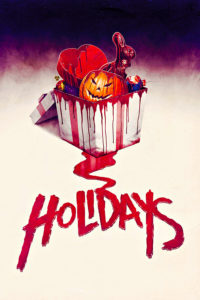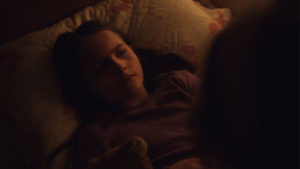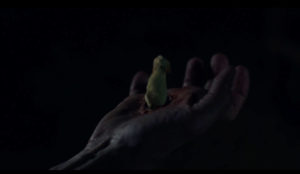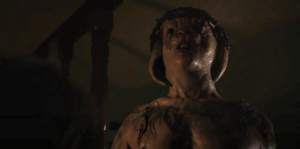 I, earlier this week, reviewed the new anthology horror film, The Dark Tapes, and declared my love for the sub-genre and the heartbreak inherent in those times when it is not done well. So, when I was thinking about an appropriate topic to write about in the midst of Holy Week and in anticipation of its culmination in Easter, my mind went to a better anthology horror film from last year, Holidays. The directors associated with the film are a mixture of widely known, up-and-coming, and relatively unknown names. The biggest name is, of course, Kevin Smith (Dogma, Clerks) who directed the vignette, “Halloween.” It’s a typical Smith feature, combining dark humor and sexually-charged grotesquerie which surrounds three cam girls and their pimp. While not totally without any merit, this is probably the vignette that fails the most to deliver something substantive to the film as a whole. Some of the up-and-coming directors consist of Dennis Widmyer & Kevin Kolsch who brought us Starry Eyes (2014) and Sarah Adina Smith, who directed The Midnight Swim (2015). A wide range of styles are represented within this collection of short films surrounding a favorite perennial subject of horror: holidays.
I, earlier this week, reviewed the new anthology horror film, The Dark Tapes, and declared my love for the sub-genre and the heartbreak inherent in those times when it is not done well. So, when I was thinking about an appropriate topic to write about in the midst of Holy Week and in anticipation of its culmination in Easter, my mind went to a better anthology horror film from last year, Holidays. The directors associated with the film are a mixture of widely known, up-and-coming, and relatively unknown names. The biggest name is, of course, Kevin Smith (Dogma, Clerks) who directed the vignette, “Halloween.” It’s a typical Smith feature, combining dark humor and sexually-charged grotesquerie which surrounds three cam girls and their pimp. While not totally without any merit, this is probably the vignette that fails the most to deliver something substantive to the film as a whole. Some of the up-and-coming directors consist of Dennis Widmyer & Kevin Kolsch who brought us Starry Eyes (2014) and Sarah Adina Smith, who directed The Midnight Swim (2015). A wide range of styles are represented within this collection of short films surrounding a favorite perennial subject of horror: holidays.
The vignettes are not consistently brilliant but there is a level of detail, art and concept that makes up for any pacing issues. However, there is one that stuck out among the rest. One that I felt pushed more boundaries than the others: Nicholas McCarthy’s “Easter.”
Now, I have to call a spade a spade before I dig into this short film. It is one of the more profane and potentially blasphemous examples of cinematic horror that I have probably ever seen. It is not for those who are sensitive about how the iconography of the faith is portrayed. The fact that I was not angered or offended by it and was nearly ecstatic to write on it probably says more about me than maybe my family, friends and church would like. But here I stand, I can do no other.
 “Easter” starts with a mother tucking her daughter into bed on the eve of Easter Sunday and the conversation that takes place is something parents have probably encountered before with particularly precocious children: the contradictions between religious and secular narratives around specific holidays. In this case, the little girl is confused by why the arrival of the Easter bunny–bringing candy overnight to her–and the celebration of Jesus’ resurrection from the dead (“like a scary version of E.T.“) coincide on the same day. Should not one or the other narrative take precedence, instead of both of them becoming watered down and mixed into an uneasy amalgam with general, ambiguous acceptance by Christians and non-Christians alike? For the girl’s part, these are great questions. Questions I often ask whenever important religious holidays come and go. However, the mother avoids her daughter’s direct challenge by diverting and misdirecting. Something we all do when we don’t have those answers worked out ourselves or we just find explanations to be inconvenient.
“Easter” starts with a mother tucking her daughter into bed on the eve of Easter Sunday and the conversation that takes place is something parents have probably encountered before with particularly precocious children: the contradictions between religious and secular narratives around specific holidays. In this case, the little girl is confused by why the arrival of the Easter bunny–bringing candy overnight to her–and the celebration of Jesus’ resurrection from the dead (“like a scary version of E.T.“) coincide on the same day. Should not one or the other narrative take precedence, instead of both of them becoming watered down and mixed into an uneasy amalgam with general, ambiguous acceptance by Christians and non-Christians alike? For the girl’s part, these are great questions. Questions I often ask whenever important religious holidays come and go. However, the mother avoids her daughter’s direct challenge by diverting and misdirecting. Something we all do when we don’t have those answers worked out ourselves or we just find explanations to be inconvenient.
When the girl wakes up in the middle of the night to get a glass of water, however, she comes face to face with the incarnation of the uncomfortable progeny of these two strange bedfellows. The creature is part man, part rabbit, though with the exception of long, dark, sweat-plastered hairs on its shoulders and chest, it is probably more man in flesh. However, its head is in the shape of a rabbit, fleshy and hairless, with ears, pink nose, and beady black eyes. Sitting atop its head, pressing down its flesh ears to the side of its face is a crown of thorns. Its hands and side are pierced in the traditional locations of Christ’s body according to church tradition. Out of the pierced hands come baby chicks, cute and yellow, which brings in a third meaning to the distorted conglomeration of being: the arrival of Spring and the pagan rituals of more ancient days. Needless to say this resurrected crucified rabbit man is an uneasy and troubling union, but, honestly, it is just as uneasy and troubling as the combination of these pluralistic meanings in the American psyche.
 The crucified rabbit man corners the little girl, pushing her finger inside the open wound on his side to, we assume, push away any doubts that this is a dream–a dark retelling of Doubting Thomas. He then tells her that since she witnessed him she would have to take his place, a strange reversal of Christ dying on the cross and taking all of our sins on Him. In a perverted sacramental moment, the crucified rabbit man places a small egg–like the candy Easter eggs–in the girl’s mouth and she partakes of “his being.” She transforms into a human flesh bunny, obscured by the camera focusing on her shadow as it morphs. She has become the new crucified rabbit woman. The mother wakes up to find her daughter gone forever. The vignette ends.
The crucified rabbit man corners the little girl, pushing her finger inside the open wound on his side to, we assume, push away any doubts that this is a dream–a dark retelling of Doubting Thomas. He then tells her that since she witnessed him she would have to take his place, a strange reversal of Christ dying on the cross and taking all of our sins on Him. In a perverted sacramental moment, the crucified rabbit man places a small egg–like the candy Easter eggs–in the girl’s mouth and she partakes of “his being.” She transforms into a human flesh bunny, obscured by the camera focusing on her shadow as it morphs. She has become the new crucified rabbit woman. The mother wakes up to find her daughter gone forever. The vignette ends.
A crucified rabbit man. Profane for sure. Blasphemous, probably. Blasphemy, though, is specifically a characteristic of created beings. God does not blaspheme otherwise He would cease to be God: God cannot not believe in God or rebel against Himself. So when we, Christians, encounter profane or blasphemous expressions, we should first look at what they say about us and the sinful actions in which we all are accessories. In this case, McCarthy is making a truly profound statement about the precarious mixture of these sincere and vital doctrines and expressions of faith and, in the case of the Easter bunny, these creations of a consumeristic culture. Add on top of that the Pagan celebrations and rituals of Spring which, much like the seasons, pop up time and again as “proof” in opposition to religious doctrine and observance. And yet Christians and non-Christians, alike, allow for all of these narratives to coexist with little to no thought about it.
Yet, especially for Christians, maybe some thought should be given to how we incorporate, accommodate and communicate these commercial elements that are, in pretty significant ways, at odds with the Christian faith. Am I saying that Christians can’t have fun hiding eggs with their kids? No. Go for it. It’s fun to watch and entertaining for the kids. I think really what “Easter” is questioning is something deeper and more insidious than just going through the actions of typical Easter activities. It is basically giving flesh to the challenge that the daughter was posing to her mother in the opening bedtime conversation: which of these competing narratives is really the aim of our worship? Which one do we actually believe?
 The complex and muddled hearts of humanity create the icons of our imperfect belief, our dedication to various gods: the strange bedfellows of faith and the world. If we are honest with ourselves, the curious crucified rabbit man is an accurate projection of the unstable devotions of our hearts. Our hearts are petri dishes of various blasphemies. This is the reason why we, Christians, hold to a faith that says God became man to save us from ourselves, from our blasphemy. The crucified rabbit man cannot save us, for it is us. It crucifies us. It places us back on that cross under the weight of our own sin and brokenness. But we know believe God crucified His Son/Himself. In a weird way, this rather uncomfortable vignette really just reminds us of the paths before us. It forces us to answer the daughter’s challenge instead of shrugging it off as if none of it really matters.
The complex and muddled hearts of humanity create the icons of our imperfect belief, our dedication to various gods: the strange bedfellows of faith and the world. If we are honest with ourselves, the curious crucified rabbit man is an accurate projection of the unstable devotions of our hearts. Our hearts are petri dishes of various blasphemies. This is the reason why we, Christians, hold to a faith that says God became man to save us from ourselves, from our blasphemy. The crucified rabbit man cannot save us, for it is us. It crucifies us. It places us back on that cross under the weight of our own sin and brokenness. But we know believe God crucified His Son/Himself. In a weird way, this rather uncomfortable vignette really just reminds us of the paths before us. It forces us to answer the daughter’s challenge instead of shrugging it off as if none of it really matters.
If I’m wrong and none of this really matters, just make sure you don’t get up for that glass of water on the night before Easter…


